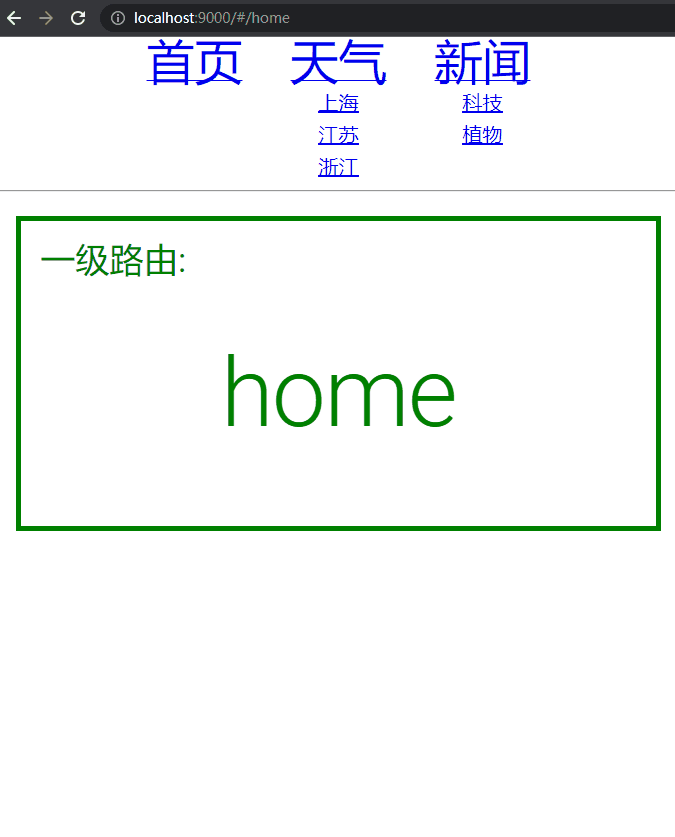用quasar+vue3+组合式api VueRouter实现路由嵌套(二级路由)
前言:
本项目使用的是quasar创建,vue3的组合式api语法。部分语法不同,但不影响理解,修改语法后可以在vue2/选项式api项目中运行。
效果图:

文件目录结构和代码如下:


文中用到的标题栏数据如下:

const titles = ref([ { name: "首页", path: "home", children: [] }, { name: "天气", path: "weather", children: [ { name: "上海", path: "shanghai" }, { name: "江苏", path: "jiangsu" }, { name: "浙江", path: "zhejiang" }, ] }, { name: "新闻", path: "news", children: [ { name: "科技", path: "technology" }, { name: "植物", path: "plant" }, ] }, ])
路由表如下(注意children里的path都没有 / ):

const routes = [ { path: "/", redirect: "/home", }, { path: "/", component: () => import("layouts/MainLayout.vue"), children: [ { path: "css", component: () => import("pages/xiaomiTitltBarCss.vue") }, { path: "cssjs", component: () => import("pages/xiaomiTitltBarCssJs.vue"), }, // /////////////////////// 测试嵌套路由 👇 ////////////////////////////////// { path: "home", component: () => import("src/pages/NestedRouters/home/HomeMenu.vue"), }, { path: "weather", component: () => import("src/pages/NestedRouters/weather/WeatherMenu.vue"), children: [ { path: "shanghai", component: () => import("src/pages/NestedRouters/weather/shanghaiSubmenu.vue"), }, { path: "jiangsu", component: () => import("src/pages/NestedRouters/weather/jiangsuSubMenu.vue"), }, { path: "zhejiang", component: () => import("src/pages/NestedRouters/weather/zhejiangSubMenu.vue"), }, ], }, { path: "news", component: () => import("src/pages/NestedRouters/news/NewsMenu.vue"), children: [ { path: "technology", component: () => import("src/pages/NestedRouters/news/technologySubMenu.vue"), }, { path: "plant", component: () => import("src/pages/NestedRouters/news/plantSubMenu.vue"), }, ], }, ], }, // Always leave this as last one, // but you can also remove it { path: "/:catchAll(.*)*", component: () => import("pages/ErrorNotFound.vue"), }, ]; export default routes;
一、只有一层路由
使用 router-link :
- router-link 通过传递 `to` 来指定链接: <router-link to="/">Go to Home</router-link>
- router-view 将显示与 url 对应的组件。你可以把它放在任何地方,以适应你的布局。
- router-link 必须和 router-view 配对使用。
<router-link class="q-mx-lg text-h3" v-for="menu in titles" :key="menu" :to="menu.path">{{ menu.name }}</router-link> <router-view></router-view>
运行结果:

使用编程式导航:
<span class="q-mx-lg text-h3" v-for="menu in titles" :key="menu" @click="topMenu(menu)">{{ menu.name }}</span> <router-view></router-view>
function topMenu(menu) { router.push(menu.path); }
运行结果:

总结:
只有一层路由时,
- 使用 router-link ,:to="menu.path",注意不加 / ;
- 使用编程式导航 router.push(meun.path) 也不加 / 。
二、嵌套路由的使用
使用 router-link :
- router-link 必须和 router-view 配对使用。
- sub-menu 的 router-view 在 HomeMenu.vue、WeatherMenu.vue、NewsMenu.vue中(如果有的话)。
- 以
/开头的嵌套路径将被视为根路径。 - 一级 router-link :to="'/' + menu.path"
- 二级 router-link :to="'/' + menu.path + '/' + submenu.path"
- 一定要注意加 / ,否则多次点击的时候路径会重复追加。
<div class="row justify-center"> <router-link class="q-mx-lg" v-for="menu in titles" :key="menu" :to="'/' + menu.path"> <span class="text-h3">{{ menu.name }}</span> <div class="column text-center text-h6"> <router-link v-for="submenu in menu.children" :key="submenu" :to="'/' + menu.path + '/' + submenu.path"> {{ submenu.name }} </router-link> </div> </router-link> </div> <hr> <div class="q-ma-lg"> <div class="box"> <p class="text-h4">一级路由:</p> <router-view></router-view> </div>
style
<style> .box { border: 5px solid green; padding: 20px; color: green; } .sub-box { color: lightcoral; margin: 50px; background-color: antiquewhite; } h1, h2 { text-align: center; } </style>
WeatherMenu.vue(注意有 router-view)
<script setup></script> <template> <h1>weather</h1> <div class="sub-box"> <p class="text-h4">二级路由:</p> <router-view></router-view> </div> </template>
运行结果:

使用编程式导航:
<div class="row justify-center"> <div class="q-mx-lg" v-for="menu in titles" :key="menu"> <span class="text-h3" @click="jumpTopMenu(menu)">{{ menu.name }}</span> <div class="column text-center text-h6"> <div v-for="submenu in menu.children" :key="submenu"> <span @click="jumpSubMenu(menu, submenu)">{{ submenu.name }}</span> </div> </div> </div> </div> <hr> <div class="q-ma-lg"> <div class="box"> <p class="text-h4">一级路由:</p> <router-view></router-view> </div> </div>
function jumpTopMenu(menu) { router.push('/' + menu.path); } function jumpSubMenu(menu, submenu) { router.push('/' + menu.path + "/" + submenu.path); }
运行效果:

总结:
当有两层或者更多路由,即路由嵌套时,
- 第一层路由 router-link :to="'/' + menu.path" 必须加 /
- 第二层路由 router-link :to="'/' + menu.path + '/' + submenu.path" 也必须加 /
- 如果不加 / ,多次点击时会重复追加路由
- 编程式导航router.push('/' + menu.path) 也必须加 /
三、 总结
- 路由表中 children 中的path 都不加 /
- router.push(path) 的路径参数总是和 router-link 中 :to="path" 相同;
- 只有一层路由时,router.push(path) 和 router-link 中 :to="path" 不用加 /
- 路由嵌套时,router.push(path) 和 router-link 中 :to="path" 都必须加 /
- 因为:以
/开头的嵌套路径将被视为根路径。






